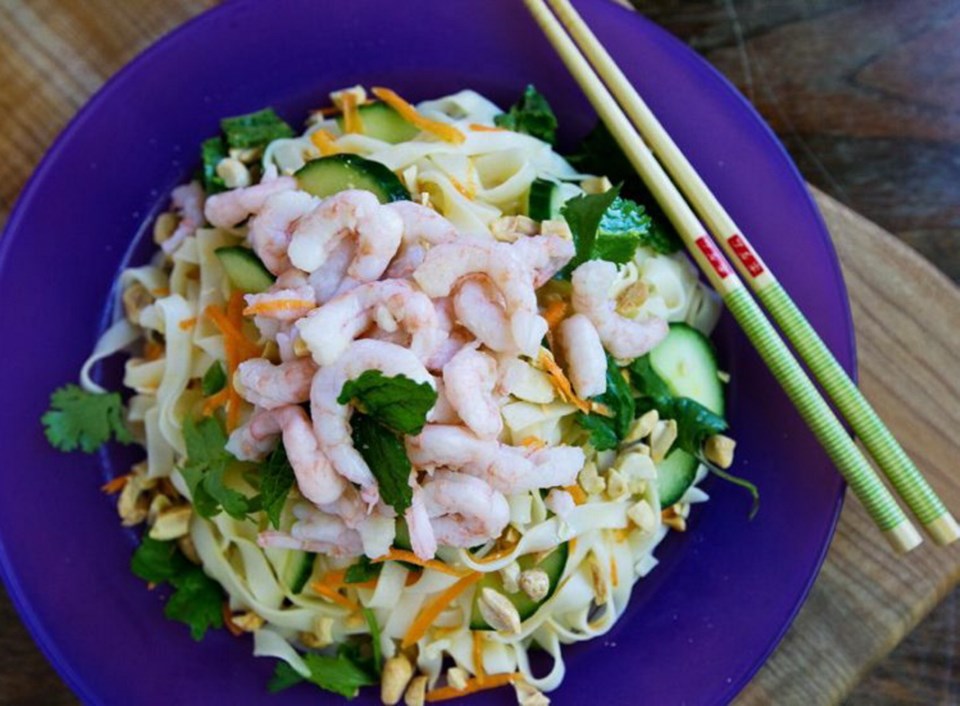 Dear Eric: I’ve looked everywhere and can’t find the noodles that my wife cooked for me almost daily in Vietnam. They don’t have a name in English, but they are made from arrowroot flour and produced near Hanoi, and readily available where we lived near Saigon. There doesn't seem to be a Vietnamese grocery store in Victoria, and I haven’t found them in Chinatown, but then neither of us can read Chinese, so they may be available there. Are you familiar with them and if so, do you know where we can buy them in Victoria?
Dear Eric: I’ve looked everywhere and can’t find the noodles that my wife cooked for me almost daily in Vietnam. They don’t have a name in English, but they are made from arrowroot flour and produced near Hanoi, and readily available where we lived near Saigon. There doesn't seem to be a Vietnamese grocery store in Victoria, and I haven’t found them in Chinatown, but then neither of us can read Chinese, so they may be available there. Are you familiar with them and if so, do you know where we can buy them in Victoria?
Kingsley and Hien
��
Dear Kingsley and Hien: I’ve not used that type of noodle before, but you gave me enough clues to see if I could track them down locally.
Clue No. 1 was that you enjoyed those noodles, and they were made in Vietnam. After doing some research, I learned of at least three main types of noodles used in that country.
They were, with the Vietnamese spelling in brackets, a thin style called rice vermicelli (bánh pho), a flat rice noodle, often called rice stick (bún), and another thin style called glass or cellophane noodle (mien).
The first two types of noodles are made from water and rice flour, the latter giving them a more solid- looking white tone when cooked. For glass or cellophane noodles, water and a starch are used. That’s because when the latter is cooked it dissolves and the noodles becomes translucent and almost clear, hence the name glass noodle.
Glass or cellophane noodles are enjoyed in a few Asian countries, such as China, Japan, Korea and, as noted, Vietnam. The starch used to make them varies from country to country and includes those made from mung bean, yam, potato and corn, among others.
In Vietnam, among those other starches is arrowroot starch, not arrowroot flour as cited in today’s question. Arrowroot starch is made from the rhizomes, a root-like underground stem, of several tropical plants.
Several sources said the Vietnamese word for arrowroot was “dong.” So I put mein and dong together, added Hanoi and did an Internet search. It didn’t take me long to find food companies selling a product with those markers. But the only problem — and a very big one — was that they were all located in the United Kingdom.
One of them was called Melbury and Appleton, and among the many items listed on their website, melburyandappleton.co.uk, were Ha Noi arrowroot bean thread noodles, a product you’ll note where Hanoi is spelled Ha Noi. Another company, Longdan, on their website, longdan.co.uk, also sold those noodles.
They sure sound like the type of noodle Kingsley and Hien are looking for, but again, those companies are in the United Kingdom. But on the Melbury and Appleton website they had a picture of the noodles and along with the English name noted above, they had the Vietnamese name, mien dong nau ha noi.
Armed with that information, I went to the two best sources I know of for a wide range of Asian-style noodles in Victoria. They are Fisgard Market in Chinatown, and Fairway Market’s Quadra Street and Shelbourne Street locations. But, alas, among the dozens of noodles offered, including the two other Vietnamese styles noted above, there were no arrowroot bean thread noodles. There were, however, lots of other noodles made with other types of starch, but they would not provide the same taste and texture Kingsley and Hien were looking for.
So, Kingsley and Hien, I’m sorry I could not help you out, but at least I provided you with some additional information that may help you locate these types of noodles in a bigger centre, such as Vancouver. I’ve also put the word out and perhaps someone in Victoria knows where you can find them.
Viewing all those noodles during my search, though, did make me want to cook some. I chose Vietnamese-style rice stick and used them in an inviting main-course salad rich with shrimp, peanuts and other good things.
��
Vietnamese-style Noodle Salad with Prawns and Peanuts
Serve this light, cool and flavourful main-course salad for lunch on a warm spring day.
Preparation time: 25 minutes
Cooking time: About 2 minutes
Makes: 4 servings
��
250 grams Vietnamese-style rice stick (see note)
1/2 cup rice vinegar
2 Tbsp vegetable oil
2 Tbsp fish sauce (see Note)
2 Tbsp granulated sugar, or to taste
1 Tbsp soy sauce
1/3 English cucumber, halved lengthwise and thinly sliced
1/2 cup coarsely grated carrot
3 green onions, thinly sliced at a slight angle
1/2 cup loosely packed fresh cilantro leaves
1/2 cup loosely packed fresh mint leaves, torn if large
1/4 cup unsalted, roasted peanuts, coarsely chopped
350 grams small, cooked salad shrimp
• Asian-style hot chili sauce, to taste (optional)
Bring a large pot of water to a boil. Add the rice noodles and cook 90 seconds to two minutes, or until just tender. Drain the noodles well, and then gently rinse in cold water to cool. Drain well again and place in a large bowl.
Place the vinegar, oil, fish sauce, sugar and soy sauce in a small bowl and mix until the sugar is dissolved. Taste the mixture and add additional sugar if you find it too tart. Add this mixture, and the cucumber, carrot, green onions, mint and cilantro, to the noodles and toss to combine.
Divide the noodles between four plates or shallow bowls, ensuring some of the bits of cucumber and herbs end up on top. Now divide and top the noodles on each salad with the shrimp and peanuts. If desired, at the table, serve the salad with Asian-style hot chili sauce, which diners can use to spice up their salads.
Note: Rice stick is a thin, flat style of rice noodle called bánh pho in Vietnamese. You’ll find them at Asian food stores and many grocery stores. Package sizes can vary. If you’ve bought one larger than the amount called for in this recipe, remove what you need and save the rest for another time.
Eric Akis is the author of The Great Rotisserie Chicken Cookbook (Appetite by Random House). His columns appear in the Life section Wednesday and Sunday.



